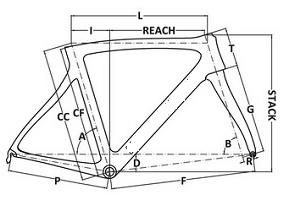
The choice of a women's racing bike frame, peculiarities and differences with a men's racing bike - Bycicles tips
The choice of a frame, referring not so much to the model or brand, but to its measurements, is always a somewhat difficult thing, especially for those who are beginners, or those who are poorly advised. Unfortunately, if the choice is varied and abundant for men, the same cannot be said for women. There are few companies that produce specific frames for female anthropometry and even fewer shopkeepers who keep them in their windows. Obviously, there is always the possibility of turning to a good craftsman, but this is a solution that often comes after several tests, perhaps unsuccessful, and a few years of experience, but it is not necessarily the only way forward.
The important thing is to understand what a woman needs, to have clear ideas and to be able to say no to those traders who, without scruples and playing on the lack of knowledge of the subject, foist a nice men's frame on a woman. In these cases, the sales technique, in the unfortunate case, is always the same: "I have this beautiful frame here (obviously with men's geometries) ..... it's the right size for you ....., then I'll fix it for you .... ". More or less it is almost always like this, based on the fact that the parameters of use are the same as the men's ones and can be easily reached by changing the handlebar stem and seat post. But let's see why it is important for a woman to have a frame built specifically for women (it doesn't matter that it is tailor-made, the important thing is that it belongs to a collection designed specifically for women). On average, a woman, compared to a man, is characterized by having the same total height, smaller hands, feet, forearms and legs, but, proportionally, a longer femur (thigh) and humerus (arm), as well as a wider pelvis. In essence, the ratios between thigh-leg and trunk-lower limb are greater in women. It is already clear that a man and a woman, despite having the same height, will never be able to use a frame with the same heights.
The woman, in fact, will need a seat tube (or vertical, or seat post tube) with a less accentuated angle (usually 72-73 degrees), in practice the seat tube will have to be inclined more backwards. This will allow the woman, who as seen has a longer femur, to keep the saddle centered on the seat post, instead of being forced to move it back as far as possible, when it is not necessary to adopt a seat post with greater setback. The shorter forearm and smaller hands, then, will lead to having a shorter stem and top tube, usually by 2-3 centimeters, in order to avoid an excessive inclination of the torso. The handlebars will also have to be different, not only narrower, in proportion to the shoulders, but above all of a different shape. With a more closed and shallow curve, as well as a reduced distance between the high and low grip. This is because smaller hands are also shorter, and with a man's curve the woman always risks having her torso too elongated when she places her hands on the low grip.
But given that a men's frame, by adopting a seat post with an adequate setback and an attachment of the right length, can be adapted to the anthropometric measurements of a woman, why worry so much, why not believe and trust the shopkeeper we hired? in question above? Achieving high performance, pedaling safely and with excellent control of the vehicle, being able to transmit all your power (much or little) to the pedals first and then to the rear wheel does not depend only on the correct height of the saddle or the inclination of the bust. First of all, it is also necessary that the weight of the cyclist, in this case the female cyclist, is correctly distributed between the two axles and that the force points exerted by the athlete are positioned in the points foreseen by the frame design. A saddle that is too far back, a handlebar stem that is too short, a torso that is too much or too little inclined, inevitably lead to an imbalance in the weights, well beyond those foreseen by the designer. Theoretically, the correct weight distribution requires that the total weight (athlete plus bicycle) is distributed 60% on the rear wheel and the remaining 40% on the front one.
When designing the frame, the technicians foresee this distribution based on statistical tables, for which dimensions are drawn, seat tube height and its angle, horizontal tube length, according to these data. Obviously the statistics of the anthropometric quotas of men are very different from those of women, and always lead to having, in order to respect the correct weight distribution, two different frames for a man and a woman who have the same height. Having said this, we carried out, thanks to the help of a collaborator, a test to confirm the validity of the theories expressed so far. The athlete who underwent the test has a bike with a men's frame, but adapted to his crotch, torso length and arms on the other hand (let's say that all the fundamental angles of the joints and the trunk are correct) on the other hand it has a more rearward saddle, with the sled almost completely towards the back and a very short handlebar stem. For the rest, we reiterate, the driving position is correct. Weighed with the bike and then in the saddle, we revealed this weight distribution: total weight of the bike plus athlete 73,600 kg, weight on the front wheel 25,000 kg, corresponding to 34% of the total weight, weight on the rear wheel 48,600 kg, corresponding to 66 % of total weight.
As we can see, the weight distribution is totally wrong, too far on the rear wheel, due to the horizontal tube being too long and the saddle being too far back. The same athlete was then placed on a women's bike her size. Having perfectly adjusted the saddle height, its setback and the length of the handlebar stem, we detected these weights: total weight of the bike plus athlete 69,150 kg, weight on the front wheel 28,000 kg, corresponding to 40.5% of the total weight, weight on the rear wheel 41.15 , corresponding to 59.5% of the total weight: as we can see, we are practically close to the theoretical optimum (which can be achieved with a custom-made frame). From an aesthetic point of view, what immediately catches the eye is the saddle centered on the seat post and the handlebar stem of an adequate length and proportionate to the length of the horizontal tube, which is much shorter. A much smaller, more proportioned and also lighter bike, with the same frame. In practice, on the road it doesn't change the way you pedal so much as the way you ride the bicycle and your safety. With more weight on the front wheel we will have greater stability both when cornering and on uneven surfaces. Turning into corners will be more precise and stable and the steering will not tend to widen when exiting corners. Furthermore, the longer attachment will allow greater handling, while maintaining stability and driving precision intact.
In the wet you will enjoy greater grip from the front wheel, again thanks to the greater weight that rests on it, and you will have less chance of blocking the wheel when braking, thanks to the greater grip, again due to the greater weight that rests on it. The more compact frame, the saddle centered on the seat tube, will then lead to a stiffer bike, again with the same frame, which will be able to transmit power to the rear wheel better. These are the significant differences that increase even more with even more "false" arrangements, as we sometimes see, with women forced with exaggeratedly elongated torsos on the bike or on the other hand "sitting" too much. In the first case we will always have precarious control of the vehicle, as well as excessive overload of the back muscles, both in the lumbar and cervical areas, with early fatigue.
In the second case, not only are you exposed too much to the wind unnecessarily, but you are in a position that is not suitable for giving the right amount of push to the pedals. In conclusion, we can understand how essential it is for a woman to pedal on a frame specifically designed for female users. As always, perfection is achieved with a tailor-made frame, in which it will be necessary to take into account, in addition to personal anthropometric dimensions, also the mobility of the lumbosacral, scapular-humeral and cervical hinge, but it is possible to achieve an excellent position even with a standard frame, as long as it is designed for female users. Other solutions are to be discarded in the most categorical way, and in the long run they can even be harmful and dangerous.
Ask a question to:
